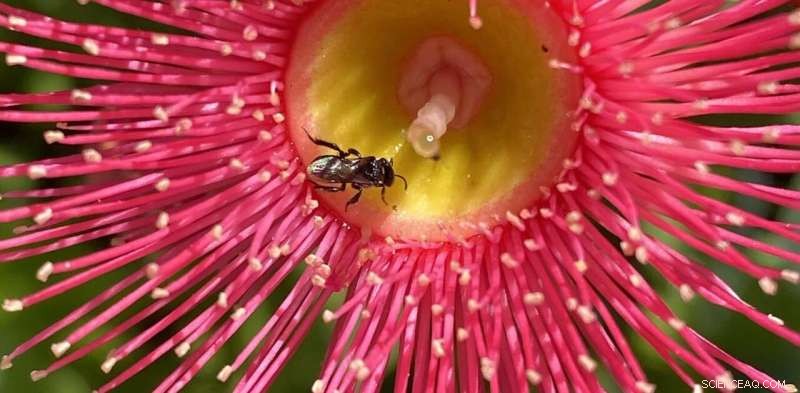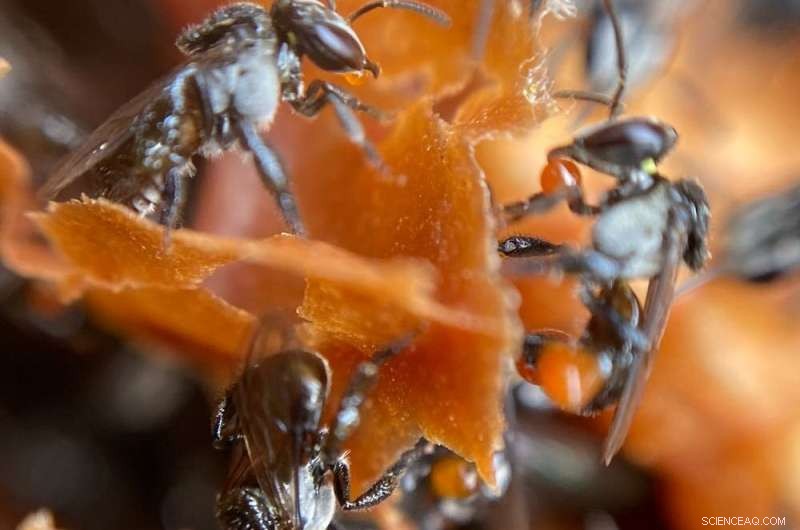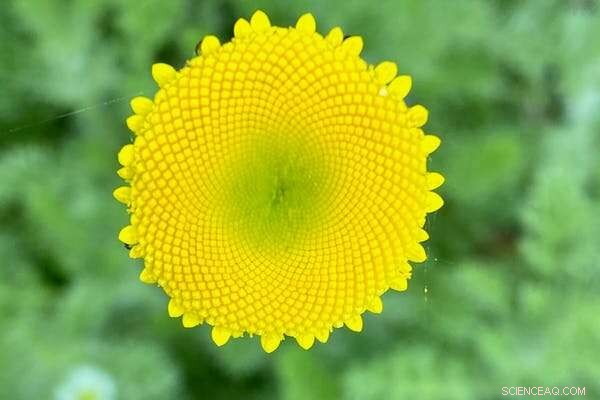
Kredit:Judy Friedlander, författare tillhandahållen
Taxonomi var en gång domänen för vitbelagda forskare med år av universitetsutbildning. Även om denna expertis fortfarande är viktig, hjälper vardagliga australiensare alltmer till att identifiera arter genom appar för medborgarvetenskap. Snabba framsteg inom smartphones och surfplattor hjälper till att popularisera denna aktivitet.
Forskare om biologisk mångfald uppmanar medborgarforskare att bidra med data för att fylla informationsluckor, identifiera artnedgångar och informera om förvaltningsbeslut. Och unga forskare – några så unga som spädbarnsskolebarn – går upp för att hjälpa till.
Berättelser som upplevelsen av 14-årige Luke Downey från Canberra inspirerar andra att spela in och ladda upp bilder till databaser med biologisk mångfald. Tidigare i år hittade Luke en sällsynt skalbagge, Castiarina testacea , senast sett i ACT 1955. Hans observation registrerades i Canberra Nature Map, ett onlineförråd av sällsynta växter och djur.
Tonåring hittar sällsynt juvelbagge vid LBG 65 år efter första ACT-observation https://t.co/EqPT0P9I5O via @canberratimes
— Dramatis Scientificae (@DramSci) 11 januari 2021
Jag satte ett makroobjektiv på min smartphone och jag blev fast
Min egen inspiration att bli en medborgarforskare var ett billigt makroobjektiv som nu permanent fästs på min smartphone. Detta lilla bärbara objektiv fotograferar små motiv på mycket nära avstånd. (Vissa nyare smartphones har inbyggda linser som kan göra detta.)
Jag fångade "felet" med att ta detaljerade närbilder som den nedan av sticklösa inhemska bin, Tetragonula carbonaria , kommunicera med varandra och beundra – eller bry sig om – deras bivax. Att dela bilderna jag har tagit har konverterat andra till den här typen av medborgarvetenskap.

Genom att fästa ett makroobjektiv på din smartphone (vissa har närbildskameror inbyggda) kan du ta bilder som detta av det infödda stingless biet, Tetragonula carbonaria. Kredit:Judy Friedlander, författare tillhandahållen
Vem som helst kan nu ta närbilder av insekter, växter och andra arter för att bidra till medborgarvetenskapliga databaser. Tydligheten i dessa bilder innebär att experter ofta kan bestämma arten, vilket ökar förståelsen för distribution och antal för att hjälpa till med bevarande på marken.
Aktiviteter som dessa ingår i B&B Highway-programmet, som drivs av PlantingSeeds Projects. Programmet uppmuntrar skolelever i New South Wales och Victoria att delta i ett medborgarvetenskapligt projekt. Det är anslutet till det internationella nätverket och databasen för biologisk mångfald iNaturalist och CSIROs Atlas of Living Australia.
Elever använder smartphones och surfplattor på skolans lekplatser för att fånga extraordinära bilder av insekter som är mindre än 1 cm långa, eller små detaljer av blomdelar. There's an online dashboard where students can see and share observations and knowledge. These images then contribute to our knowledge of species distributions and densities.
Focusing on pollinators
The B&B Highway program has developed a biodiversity-based curriculum with the NSW Department of Education. The project includes plantings and constructed habitats at schools to form regenerative corridors. It has a target of over 60 hubs by mid-2022 to help counter the alarming decline in pollinators in Australia and around the world.
The B&B Highway program provides training for teachers and students. While students are often more at ease with smart devices and their camera functions than their teachers, separate instructions are given to school administrators to set up an iNaturalist account and upload observations. Having a school account ensures students' identities are protected and all observations are listed as the schools."
Children under the age of 13 cannot create an account or engage directly with many citizen science communities, including iNaturalist. This means an adult needs to upload observations.

The photos you take can help fill the gaps in knowledge about the distribution and abundance of pollinators and the flowers they visit. Credit:Judy Friedlander, Author provided
An observation is regarded as research grade if at least two site users agree on the identification to the taxonomic species level. Observations on iNaturalist are shared with the Atlas of Living Australia.
Taxonomists regularly report concern at the lack of data on the distributions and densities of insect pollinators. This month's addition of 124 Australian species to the International Union for Conservation of Nature's (IUCN) Red List of Threatened Species means urgent strategies—including citizen science—are needed to help regeneration.
Urban observations are important as about 30% of Australia's threatened species occur in cities. Yet only about 5% of citizen science projects in Australia are urban-based. With three-quarters of Australia's 23.4 million people now living in a capital city, the citizen science potential is enormous.
Some tips from the experts
The following tips drawn from the iNaturalist teacher's guide will help you get started.
Take identifiable photos. Try to fill the frame with your subject. It may help to use your hand to hold a flower or plant still, but make sure the plant is not dangerous.
Take multiple photos. Many organisms, particularly plants and insects, cannot be identified to species level from a single photo. Take several photos from different angles. For plants, photos of flowers, fruit and leaves are all helpful for ID.

Observations of wild species, like this King Parrot, Alisterus scapularis, are of more scientific value. Kredit:Författare tillhandahålls
Focus on wild organisms. In general, the iNat community is more interested in wild organisms. Members respond more to pictures of weeds and bugs than cultivated roses and hamsters in cages.
Pay attention to metadata. This is the information associated with a photo that captures when and where (if location services are on) a photo was taken. Screen shots of photos will lose this data, which may result in incorrect data entry. Watch for locations and dates that don't make sense. If your device's time and date settings are wrong, the data will be wrong.
Don't feel pressured to make research grade observations . Many organisms cannot be identified to the species level using only photographic evidence so observations of them may never attain research grade.
Be aware of copyright. Images should not be copied from books or the internet to illustrate what you observed. Post only your own photos.
Check out Seek. Seek is an educational tool built on iNaturalist. It does not actually post observations to iNaturalist but provides tools such as automated species identification (when possible) and nature journalling.